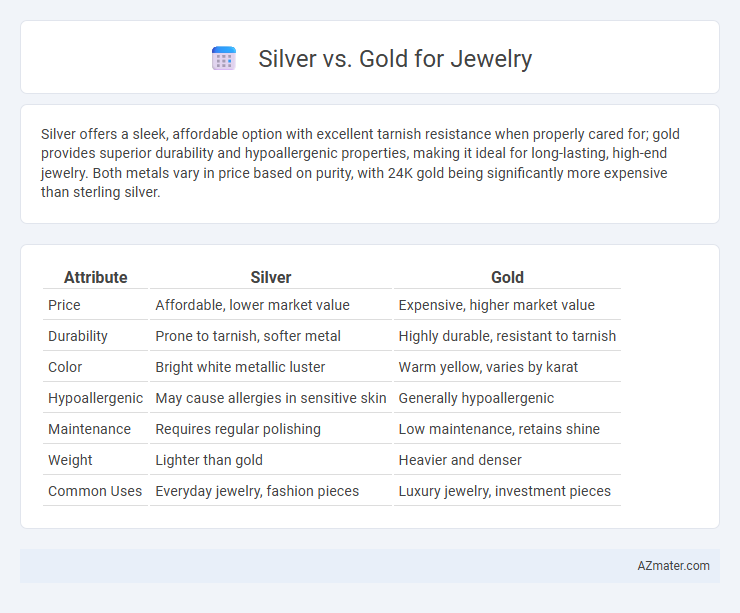Silver offers a sleek, affordable option with excellent tarnish resistance when properly cared for; gold provides superior durability and hypoallergenic properties, making it ideal for long-lasting, high-end jewelry. Both metals vary in price based on purity, with 24K gold being significantly more expensive than sterling silver.
Table of Comparison
| Attribute | Silver | Gold |
|---|---|---|
| Price | Affordable, lower market value | Expensive, higher market value |
| Durability | Prone to tarnish, softer metal | Highly durable, resistant to tarnish |
| Color | Bright white metallic luster | Warm yellow, varies by karat |
| Hypoallergenic | May cause allergies in sensitive skin | Generally hypoallergenic |
| Maintenance | Requires regular polishing | Low maintenance, retains shine |
| Weight | Lighter than gold | Heavier and denser |
| Common Uses | Everyday jewelry, fashion pieces | Luxury jewelry, investment pieces |
Introduction to Silver and Gold in Jewelry
Silver and gold are two of the most popular metals in jewelry making, prized for their unique properties and timeless appeal. Silver offers a lustrous shine and affordability, making it ideal for everyday pieces, while gold is valued for its durability and rich, warm tones available in various karats and colors such as yellow, white, and rose gold. Both metals hold significant cultural and historical importance, frequently used in rings, bracelets, necklaces, and earrings to create elegant and lasting jewelry collections.
Historical Significance of Silver and Gold
Silver and gold have held immense historical significance as symbols of wealth and status across ancient civilizations, including Egypt, Mesopotamia, and the Roman Empire. Gold was often reserved for royalty and religious artifacts due to its rarity and resistance to tarnish, while silver was valued for its affordability and versatility in everyday jewelry and currency. These precious metals have influenced trade, culture, and craftsmanship for millennia, shaping the artistic and economic heritage of societies worldwide.
Physical Properties: Silver vs Gold
Silver has a Mohs hardness of 2.5-3, making it more prone to scratches and dents compared to gold, which ranges from 2.5 to 3 in its pure form but becomes considerably harder (up to 4) when alloyed. Gold's higher density, approximately 19.3 g/cm3, gives it a heavier feel and greater durability than silver, which has a density of about 10.5 g/cm3. Both metals exhibit excellent malleability and corrosion resistance, but gold is less reactive, maintaining its luster longer without tarnishing, unlike silver which oxidizes and requires regular polishing.
Aesthetic Appeal: Shine, Color, and Style
Silver jewelry offers a bright, cool-toned shine with a sleek, modern aesthetic that complements minimalist and contemporary styles. Gold jewelry provides a warm, rich luster, ranging from yellow to rose hues, enhancing classic and luxurious designs. Both metals reflect light differently, with silver producing a sharper gleam and gold offering a softer, radiant glow that influences the overall style statement.
Durability and Longevity Comparison
Gold jewelry, especially 14k and 18k, offers superior durability due to its alloy composition, making it more resistant to tarnish and scratches compared to silver. Silver, primarily sterling silver, tends to tarnish faster and requires regular polishing to maintain its shine, though it is softer and more prone to dents and wear over time. For long-term jewelry investment, gold retains its appearance and value better, making it a preferred choice for pieces intended to last decades.
Hypoallergenic Qualities of Silver and Gold
Silver and gold are both popular choices for hypoallergenic jewelry, but gold, especially in its higher karat forms (18K and 24K), tends to cause fewer allergic reactions due to its purity and lack of nickel. Sterling silver often contains small amounts of copper or nickel, which can trigger sensitivities in some wearers, making it less ideal for highly sensitive skin. Hypoallergenic jewelry made from high-purity gold provides a safer option for those prone to metal allergies, combining luxury with skin-friendly properties.
Maintenance and Care Requirements
Silver jewelry requires regular polishing to prevent tarnishing caused by exposure to air and moisture, and it should be stored in anti-tarnish bags or cloths to maintain its shine. Gold jewelry, especially higher karat varieties like 18K or 24K, is more resistant to tarnish and corrosion but can still benefit from occasional cleaning with gentle soap and water to remove oils and dirt. Proper maintenance for both metals includes avoiding harsh chemicals, storing pieces separately to prevent scratching, and routine professional inspections to preserve their appearance and durability.
Price Differences and Investment Value
Silver jewelry typically costs significantly less than gold due to its lower market price per ounce, making it more accessible for everyday wear. Gold, particularly 24K or 18K, has a higher intrinsic value and tends to retain or appreciate over time, offering better investment potential. While silver fluctuates more with industrial demand, gold remains a stable asset often favored by investors for wealth preservation.
Popular Uses in Modern Jewelry Design
Silver is widely favored for modern jewelry design due to its affordability, versatility, and bright, reflective shine that complements casual and formal styles. Gold remains a symbol of luxury and timeless elegance, commonly used in high-end pieces, engagement rings, and intricate designs featuring yellow, white, or rose gold alloys. Both metals adapt well to trends such as minimalist, bohemian, and mixed-metal styles, making them essential materials in contemporary jewelry collections.
Choosing Between Silver and Gold for Your Next Piece
Choosing between silver and gold for your next jewelry piece depends on factors like skin tone compatibility, budget, and durability preferences. Silver, typically more affordable and ideal for cool skin tones, offers a sleek, modern look but may tarnish over time. Gold, available in yellow, white, and rose varieties, provides a timeless elegance, higher durability, and is often chosen for investment value despite its higher price point.

Infographic: Silver vs Gold for Jewelry
 azmater.com
azmater.com